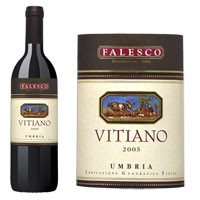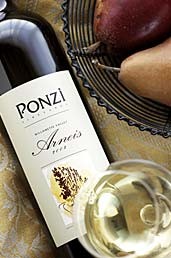I’ve had the pleasure of sipping a lot of really good wines lately, some of which I’ve recommended on the WineBoy Webcast. So, as your ever- accommodating wineaux, here are some vinous goodies for your consideration:
2006 Falesco Vitiano ($14)From the Italian state of Umbria, this blend of sangiovese, merlot and cabernet sauvignon, is a medium-bodied red with loads of bright cherry flavors and nice balancing acidity. Year in and year out Vitiano is one of my favorite value-priced Italian wines. It should pair well with roasted meat dishes or pasta dressed in a light tomato sauce.
2006 Rombauer Napa Valley Chardonnay ($30)In recent years, I must admit to avoiding what I perceive to be “over-done and over-oaked” California chardonnay. It’s not that I don’t occasionally appreciate over-ripe, high alcohol chardonnay that has been aged in heavily toasted oak barrels. Well…. yes it is. And so when I put a glass of Rombauer Chardonnay to my lips recently I was expecting to dislike it. After all, it was from Napa and had been aged in oak for an extended period of time.
Surprise! It is a well-balanced chardonnay with -- yes -- a toasty oak component. Yet the wine is also full of ripe tropical fruit flavors that are balanced by excellent acidity. As a matter of fact, we drank this wine with pasta tossed in a sauce of scallops, arugula and pine nuts, and the combination was heavenly. This wine, produced from the cooler growing region of Carneros in southern Napa, has restored my faith in fuller-flavored chardonnay. Say hallelujah!
2004 Ferrari-Carano Sonoma Merlot ($25)
I know it’s popular now to bash merlot, but I’ve never been one to kick a good wine when it’s down, particularly when the stuff is as good as this. First of all, 2004 was a very good vintage year for northern California reds. The Ferrari-Carano folks selected merlot from several different appellations in Sonoma County, including Alexander Valley, Russian River and Dry Creek, to make its wine. The result is a round, rich, full-flavored wine full of spicy, chocolate flavors with medium tannins that is enjoyable now, but will get better  over the next five or so years. This baby just begs to be married to a large slab of grilled, peppercorn encrusted red meat!
over the next five or so years. This baby just begs to be married to a large slab of grilled, peppercorn encrusted red meat!
2006 Yalumba South Australia Viognier ($13) Viognier has become a nice alternative to some wines I call porch sippers – like riesling, Muscat or even gewürztraminer. This particular wine is finished with what seems to me like about a percent of residual sugar, but it also has some weight to it and the flavors of apricot and peach are intense. Try it as an aperitif before dinner or as an accompaniment to spicy stir fry or oriental dishes like Pad Thai.
2006 Seghesio Sonoma Zinfandel ($20) One of the reasons I love zinfandel is that, while it is a full-flavored wine, it can be enjoyed in its youth. Big and juicy, the Seghesio is a symphony of blackberry, chocolate and mint tones that satisfies my hedonistic cravings (as far as wine goes) with flavors that explode on the palate. Nothing subtle here, but if you like “real” zinfandel, you’ll love this baby. And if you like grilled lamb (that had been marinating in a bath of olive oil, garlic, black peppercorns, rosemary and red wine for a day or so), you must wash it down with this wine.






